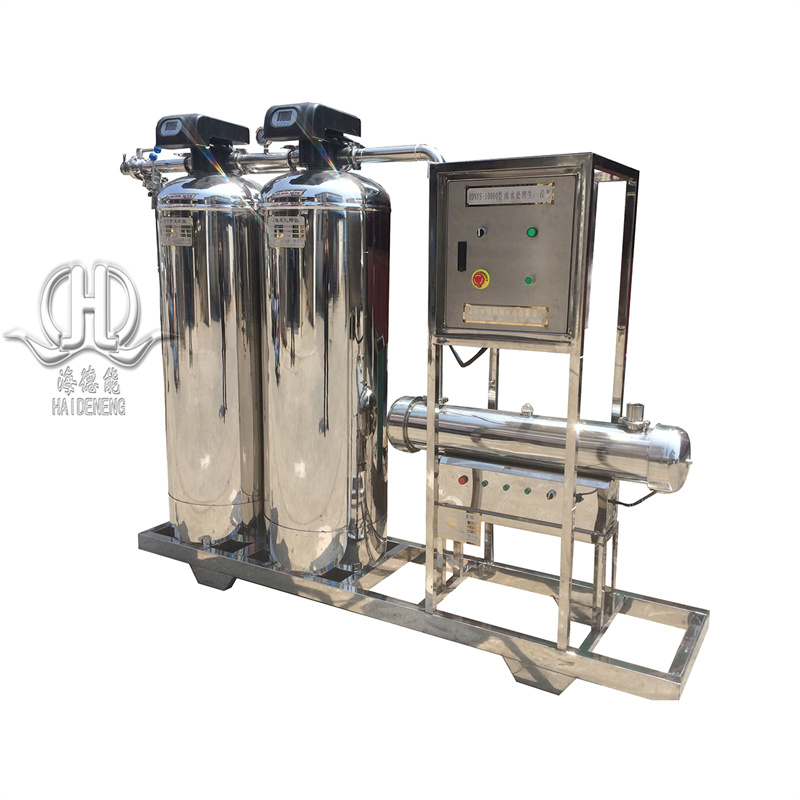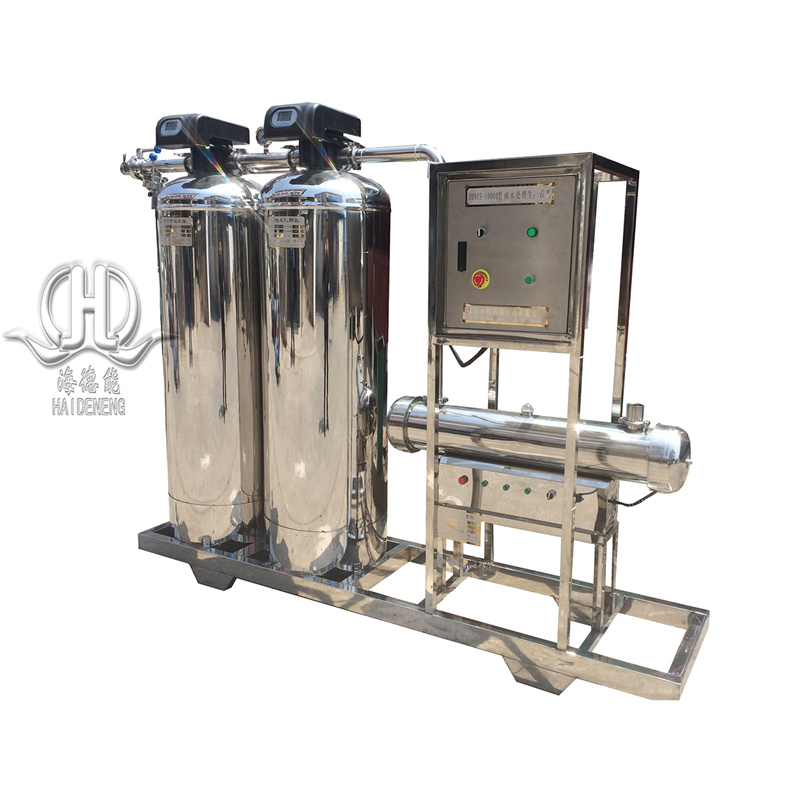Sand filter carbon filter fully automatic reverse osmosis removal of impurities and odors water treatment equipment
Product description
This device is an integrated water purification system that efficiently removes suspended solids, organic matter, odors, and soluble impurities from water through the synergistic effect of physical filtration, adsorption purification, and membrane separation technology. It is widely used in households, businesses, and small industrial scenarios, especially suitable for treating water sources with turbidity and odor problems (such as groundwater and tap water secondary pollution water). The following provides a detailed explanation from three aspects: system composition, working principle, and core functions:
1、 Core components and functions of the system
1. Sand Filter – Remove suspended impurities
Construction: Pressure bearing tank body (mostly made of fiberglass or stainless steel), filled with quartz sand of different particle sizes (upper coarse sand, lower fine sand, forming a gradient filtration layer), equipped with automatic control valves (to control the filtration and backwash process).
Core role:
By physically intercepting and removing suspended impurities such as sediment, rust, algae, and colloidal particles from water, turbidity can be reduced (usually from 10-30NTU to below 1NTU);
Intercept large particulate matter to avoid scratching subsequent activated carbon and reverse osmosis membranes, providing a foundation for deep purification.
Operating characteristics: Fully automatic backwashing (when the inlet and outlet water pressure difference exceeds 0.05MPa or timed for 8-12 hours), without manual intervention, restoring the filtering capacity of the filter material.
2. Carbon Filter – removes odors and organic matter
Construction: The interior of the tank is filled with granular activated carbon (preferably coconut shell activated carbon, with a specific surface area of ≥ 1000m ²/g and stronger adsorption performance), which operates in conjunction with the sand filter.
Core role:
Adsorption of odors: By using the porous structure of activated carbon to adsorb odors (such as earthy and fishy odors) generated by humic substances, algal metabolites, etc. in water, the water quality and taste are improved;
Removing organic matter and residual chlorine: adsorbing pesticide residues, industrial solvents and other organic matter, as well as residual chlorine (Cl ₂ HClO), Prevent residual chlorine oxidation from damaging subsequent reverse osmosis membranes;
Discoloration: Removing natural pigments (such as yellow caused by iron and manganese) from water, making the water clear and transparent.
3. Fully automatic reverse osmosis device (RO System) – deep removal of soluble impurities
Core structure:
Precision filter (5 μ m PP filter element, serving as a “security barrier” for reverse osmosis membrane, intercepting small particles);
High pressure pump (providing 1.0-1.5MPa pressure to drive water molecules through the reverse osmosis membrane);
Reverse osmosis membrane module (roll type composite membrane, pore size 0.0001 μ m, allowing only water molecules to pass through);
Fully automatic control system (PLC+touch screen, controlling operation, flushing, alarm and other processes).
Core role:
Deep impurity removal: Through the selective permeability of reverse osmosis membranes, more than 99% of soluble salts (such as calcium and magnesium ions), heavy metals (such as lead and arsenic), bacteria, viruses, etc. are intercepted, greatly improving the purity of the produced water;
Enhanced deodorization: further remove trace organic matter that has not been adsorbed by activated carbon to ensure that the produced water is odorless;
Fully automatic operation: supports one click start, automatic flushing (flushing membrane surface impurities during startup/shutdown), water quality monitoring (automatic discharge when water production does not meet standards), reducing operational difficulty.
2、 System workflow
Preliminary filtration (sand filtration stage):
The raw water first enters the sand filter, where quartz sand intercepts large suspended impurities (such as sediment and rust), reduces turbidity, and reduces the load for subsequent treatment.
Adsorption purification (carbon filtration stage):
The sand filtered water enters the carbon filter, where activated carbon adsorbs odors, organic matter, residual chlorine, and pigments in the water, improving the water quality in terms of smell and vision.
Precision protection (security filtering):
The water passes through a 5 μ m precision filter to retain residual impurities such as activated carbon powder and fine colloids, avoiding damage to the reverse osmosis membrane.
Deep purification (reverse osmosis stage):
The high-pressure pump pressurizes the water and sends it into the reverse osmosis membrane module. Water molecules pass through the membrane to form “produced water” (pure and odorless), while soluble impurities, bacteria, etc. are intercepted to form “concentrated water” and discharged.
Intelligent control:
The system monitors pressure, flow rate, and water quality in real-time, automatically adjusts operating status, and completes maintenance processes such as backwashing and membrane cleaning fully automatically to ensure stable operation.
3、 Core advantages and applicable scenarios
Core advantages
Comprehensive purification: sand filtration to remove suspended solids, carbon filtration to remove odors, deep reverse osmosis to remove impurities, achieving a full chain improvement of “turbidity → odor → purity”;
High degree of automation: from filtering to maintenance, the entire process is automatically controlled without the need for dedicated personnel, suitable for home and small business scenarios;
Strong adaptability to water quality: capable of treating various water sources such as groundwater (containing sediment, iron and manganese odors), tap water (residual chlorine odor, secondary pollution), etc;
Stable water quality: turbidity ≤ 0.1NTU, no odor, total dissolved solids (TDS) can be reduced to below 50mg/L, meeting direct drinking standards.
Typical Applicable Scenarios
Home water purification: treating tap water or well water, providing direct drinking water for the kitchen, cooking soup and rice, and solving problems such as scale and odor;
Commercial venues: small restaurants and cafes used for making beverages and enhancing taste; Improving the water quality of guest rooms in homestays and hotels;
Small office: Office direct drinking water system, replacing bottled water, safer and more convenient;
Rural water supply: deal with high turbidity and odorous well water to improve the safety of drinking water for villagers.
summarize
This device uses a golden combination of “sand filtration+carbon filtration+reverse osmosis” to solve problems such as turbidity, odor, and excessive impurities in water quality, with both purification efficiency and ease of operation. Its core value lies in breaking down complex water quality problems step by step, ultimately producing clear, odorless, and low impurity high-quality water, which is an ideal choice for improving water quality in small and medium-sized scenarios.










